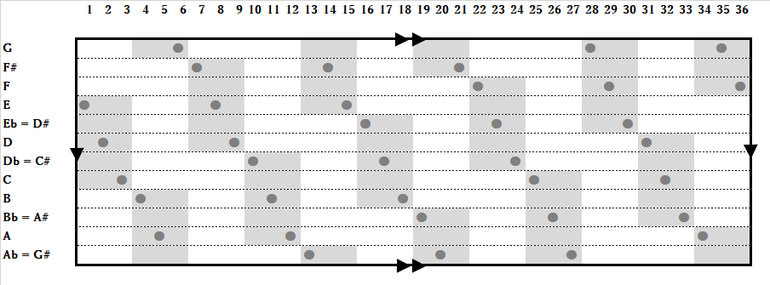トリコルダーレ音楽について/About "tricordale” music
vol. 34 2021-06-09 0
フランチェスコ・ヴァルダンブリーニ(1933~2007)は、「トリコルダーレ(tricordale)音楽」の指導者でした。
これは2全音程を形成する3音(tricord bítono)をもちいて、協和(consonanza)と不協和(dissonanza)の二項対立的な弁証法をこえて、無限の「和」(”sonanza” infinita)へといたる精神の美学であり、存在論的瞑想です。客体としてのコード(chord)と主体としてのコードの後にくる第三のコードが、対峙する主観と客観を合成し、有限性の緊張にあって無限を思考する精神の自由な活動です。
トリコルダーレ音楽におけるtricord bìtonoの反復は、反復が反復にとどまり減衰することなく、むしろ、反復の反復が差異を生む「構造」であり、オクターブが決定付けてきたあらゆる制約を異化していくことになります。オクターブという、12の同値類による分割があったからこそ、旋法的、調性的なあらゆるゲームが、ときには数秘術のようなものでさえ、可能だったのであり、メロディー・和声・対位法が作曲上のリアリティを得ていたのです。クラスターでさえ結局、半音階主義と同様、オクターブ内の12音というゲットーを追認し続けることになります。
一方、トリコルダーレ技法においては、3音の各々はあくまでも、bìtone(2全音程)=tricord(3つの弦)の微分として生成し、たとえば、36音や72音の「重複しない」音の連鎖を可能にします。たとえば、D-E、D-Cという音程から合成されるトリコルドE D Cにはじまる、B A G、F# E D、C# B A、G# F# E、D# C# B、A# G# F#、F Eb Db、C Bb Ab、G F Eb、D C Bb、A G Fという36音の連鎖が可能です。最初の連続した3つのトリコルドの継起で既にオクターブがのりこえられます。この連続する36音を形成する12のトリコルドは短二度で互いに結合しています。下の図をみると、同型の音が一音もないことがわかります。なお、72音の連鎖は、トリコルドを互いに結合する音程を、短二度、長二度、短二度、長二度、...というふうに振動させることによってえられます。これ以外にも多くの手法があります。
Francesco Valdambrini was the leader of the "tricordale" music, one of the last century's innovations of the compositional musical technique, which makes use of the "tricord bítono" (three notes that together form two whole tones), and which is based on an essentially spiritualistic aesthetics, which overcomes the binary dialectic of consonance and dissonance and inaugurates the "Infinite Sonance" intended as ontological meditation. "Tricordale" music means that after the first objectivist chord and the second subjectivist chord there is the third one, which is the synthesis and cancellation of the conflict between subjectivism and objectivism in a free spiritual thinking above tensions, but towards infinity. In this sense, the structure of the "tricordale" music proposes the "tricord bìtono" that, in its constant repetition, overcomes any constraint determined by the octave, as a limiting environment of 12 notes with different names, within which took place, in modal and tonal music, all the games, even if numerologically very bold, that gave body [= embodied] to the melodic, harmonic and contrapuntal realities of compositions. It may seem strange, but even clusters, as well as the total-chromatic, end up confirming and continuously reconfirming the ghetto of the 12 notes within the octave. The "tricordale" technique, on the other hand, proposes the use of "bìtone" trichords in various ways that differentially color the three notes that compose it, and that, since the earliest compositions of this type, present concatenations of trichords in successions of 36 or 72 different notes that, in their theoretical unfolding, for example E D C - first bi-tone trichord composed of two whole tones D-E and D-C then B A G, F# E D, C# B A, G# F# E, D# C# B, A# G# F#, F Eb Db, C Bb Ab, G F Eb, D C Bb, A G F (36 notes), already after the utterance of 3 successive trichords, overcome and cancel the octave ghetto. As it is already easy to notice, the trichords of this succession of 36 notes are linked to each other by the consecutive interval of minor second. The concatenation of 72 notes, on the other hand, entails the linking of the trichords to each other by alternating the interval of minor second between the first and the second with the interval of major second between the second and the third, and so on. In addition to these two procedures there are many others.

 FUNDED
FUNDED
